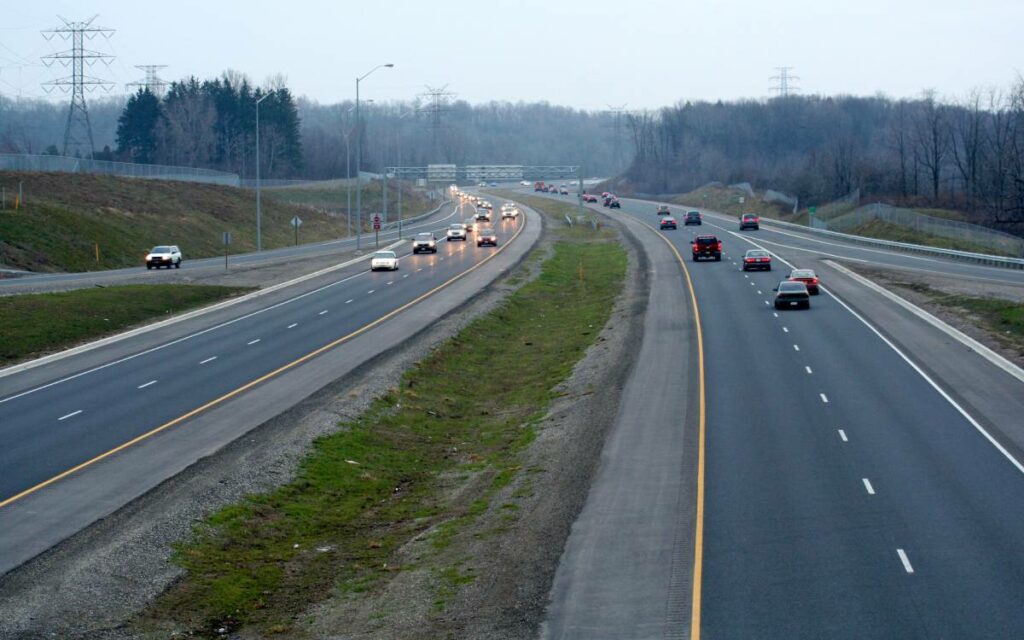
A $28 million public inquiry report on the Red Hill Valley Parkway (RHVP) suggests low friction levels contributed to collisions before 2019. Justice Herman Wilton-Siegel’s findings highlight withheld information that could have prompted earlier safety measures, such as speed limit adjustments, potentially reducing accidents. Photo credit: Wikimedia Commons
A public inquiry into friction levels on the Red Hill Valley Parkway (RHVP) that was ordered by the city in 2019 was released on November 29, 2023. The Inquiry cost the city $28 million.
The final report by Justice Herman Wilton-Siegel determined that “relatively low RHVP friction levels were a likely contributor to collisions” prior to 2019, when the road was repaved.
Hamilton City Council ordered the Inquiry after city staff discovered the Tradewind Report in 2019, which involved friction testing, which was completed in 2013 and noted issues with friction levels on the parkway.
The RHVP opened in 2007.
Previously, the Tradewind Report had been kept relatively secret by Director of Engineering Services Gary Moore, who did not share it with other staff or council, calling the results “inconclusive.”
Moore retired in May 2018 and was succeeded by Gord McGuire, who later found the Tradewind Report and the associated 2014 Golder Report and notified other staff and eventually council.
However, it appears that the friction issues were not necessarily due to the aggregate used to construct the parkway, as some had theorized.
Wilton-Siegel notes that the Inquiry “did not receive any evidence that indicated that the frictional or other characteristics” of the aggregate used for the parkway “were inadequate at the time of construction.”
“The uncontroverted evidence before the Inquiry was that no further assessment, remediation, or action was warranted in 2007 because the results were acceptable for newly paved stone matrix asphalt pavement.”
The Inquiry notes that after heavy rainstorms in September 2013, “the city’s road maintenance staff…raised concerns within Public Works that they, the police, and the public believed that the RHVP was unduly ‘slippery when wet.’”
As such, Moore arranged for friction testing, the results of which were provided to him in the Tradewind Report in 2014.
The RHVP had its first fatal collision in 2012, its second in 2015, and by 2018 seven people had died in collisions.
The Tradewind Report raised questions about the friction on the RHVP and recommended “a further examination of the pavement surface, composition, and wear performance” of the parkway.
However, Moore dismissed the report.
Wilton-Siegel writes, “At a minimum Mr. Moore should have ensured that a further investigation into the pavement condition was completed to understand the circumstances resulting in the low friction levels.”
Wilton-Siegel continues that there “was no justification for Mr. Moore’s failure to provide a copy to his colleagues” and that he regards it as “misconduct” on the part of Moore.
Furthermore, Wilton-Siegel writes, “In addition, Mr. Moore provided inadequate, incomplete, or inaccurate information about the Tradewind Report and/or Tradewind’s friction testing and the results thereof on three occasions,” which also constitutes as “misconduct.”
Moore then retired in 2018. McGuire took over and eventually came across the Tradewind Report.
McGuire discussed the document with city staff and eventually brought the matter to Council.
After that, Council eventually launched a public inquiry into the matter.
The speed limit on the parkway was also lowered from 90 km/h to 80 km/h in 2019, and the road was repaved.
The Inquiry notes that in addition to friction issues, “elements of the RHVP geometry make the roadway challenging to drive, particularly in the area between the Greenhill Avenue and Queenston Road interchanges, which requires a higher friction supply in order to execute maneuvers in that area.”
“In any event, the Inquiry has seen nothing to suggest that the friction levels on the RHVP were so low that friction in and of itself was a cause of accidents in the absence of other contributing factors.”
“The fact that parts of the roadway are challenging to drive makes the friction supply required to meet that friction demand more important than in other situations.”
The report concludes that there is “ample evidence that friction levels were a contributing factor generally to collisions on the RHVP, and especially on wet pavement. However, there are many potential contributing factors to collisions and other accidents on a roadway.”
Wilton-Siegel writes, “The Tradewind Report did not identify an urgent concern, whether relating to pavement condition or traffic safety, but it did identify a condition that could, under some circumstances, be a contributing factor to collisions, particularly under wet surface conditions.”
He further posits, “The Tradewind Report was credible; its contents and its recommendation for further investigation should have been taken seriously.”
“In particular, I think that it is reasonable to assume that Traffic would have recommended a reduction in the posted speed limit on the RHVP and enhanced speed enforcement earlier than 2019.”
“Accordingly, it is logical to assume that the failure to disclose the Tradewind Report, or the information and recommendations contained in the Report, resulted in users of the RHVP being exposed to more risk than would have been the case if those countermeasures had been implemented earlier.”
“For the same reason, it is also logical to assume that the failure to disclose the Tradewind Report contributed to accidents and injuries on the RHVP since January 2014.”
The full report, which is over 1,000 pages long and includes an Executive Summary and two volumes, can be viewed here.

Based in Hamilton, he reaches hundreds of thousands of people monthly on Facebook, Instagram, TikTok, and Twitter. He has been published in The Hamilton Spectator, Stoney Creek News, and Bay Observer. He has also been a segment host with Cable 14 Hamilton. In 2017, he received the Chancellor Full Tuition Scholarship from the University of Ottawa (BA, 2022). He has also received the Governor General’s Academic Medal. He formerly worked in a non-partisan role on Parliament Hill in Ottawa.






